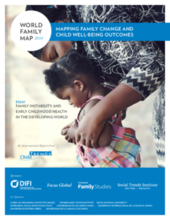The second annual edition of the World Family Map has been published by Child Trends, providing fascinating information on global changes in the areas of family structure, family socioeconomics, family processes, and family culture. The report investigates how family characteristics affect children’s healthy development around the globe and includes a new essay focusing on union stability and early childhood health in developing countries. This edition includes information on 16 indicators of family well-being selected by an expert group because of their known relationships to child outcomes in the research literature, across 49 countries, representing a majority of the world’s population. The report highlights that “Families do not operate in a vacuum: their ability to provide for their children and supervise their development depends not only on parenting behaviors and attitudes but also on the social, economic, and policy environments that surround them.” Family living arrangements—how many parents are in the household and whether the household includes extended family members—shape the character and contexts of children’s lives, as well as the human resources available for children.
The report finds that, despite major family changes around the globe over the last half-century, children are still most likely to live in two-parent families in all countries except South Africa. Growing up with a single parent is especially common in sub-Saharan Africa, in Central and South America, and in several English-speaking Western countries; in the U.S., the U.K., New Zealand, and Canada, a fifth or more of children do so. Extended families, which can compensate for the absence of one or both parents from the household, are most commonly found in sub-Saharan Africa, followed by Asia and Central/South America. The essay also highlights that in lower-income countries, single motherhood is more common among better-educated and wealthier mothers, in contrast to the typical pattern in higher-income countries. Living with kin is particularly common in much of Asia, the Middle East, Central/South America, and sub-Saharan Africa. In almost all of the countries in these regions, at least 40 percent of children live in households with other adults besides their parents. In many cases, these adults are extended family members.
The essay specifically explores the relationship between family instability—measured by divorce or dissolution of a cohabiting relationship, widowhood, or repartnership, either through marriage or cohabitation—and children’s health. Three measures of child health are explored to cover different types of indicators of health: 1) diarrhea, an acute illness; 2) stunting, a longer-term measure of health resulting from chronic nutritional deprivation or repeated episodes of poor food intake, disease, or both; and 3) child mortality, the ultimate negative health outcome. The findings presented in the essay suggest that family instability compromises parents’ ability to provide the kind of consistent and attentive care that is most likely to foster good health in children. The mechanisms of family instability that may compromise children’s health might include increased levels of stress, less focus on the child, a reduction in social support, and a decrease in socioeconomic resources. The authors point out that extended kin networks, communities, and private and public programs can do much to alleviate these stressors as families go through these transitions so as to improve health outcomes for children who experience such instability. The findings suggest many opportunities to improve family and thus child well-being globally, include fostering union stability (assuming parents have low-conflict relationships), extended family support, improving nutrition and parental education, and encouraging parent-child communication, among others.
For more information see: http://worldfamilymap.org/2014/articles

